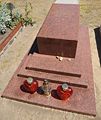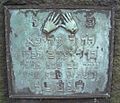Jewish cemeteries
Jump to navigation
Jump to search
cemetery for Jewish people | |||||
| Upload media | |||||
| Subclass of | |||||
|---|---|---|---|---|---|
| Culture | |||||
| Religion or worldview | |||||
| Different from | |||||
| |||||
Pebbles
[edit]English: Even when visiting Jewish graves of someone that the visitor never knew, the custom is to place a small stone on the grave using the left hand. This shows that someone visited the gravesite, and is also a way of participating in the mitzvah of burial. Leaving flowers is not a traditional Jewish practice. Another reason for leaving stones is to tend the grave. In Biblical times, gravestones were not used; graves were marked with mounds of stones (a kind of cairn), so by placing (or replacing) them, one perpetuated the existence of the site.
Français : petits cailloux
Deutsch: Es ist Sitte, beim Besuch eines jüdischen Grabes einen (kleinen) Stein auf dem Grab zu hinterlegen.
cemetery for Jewish people | |||||
| Upload media | |||||
| Subclass of | |||||
|---|---|---|---|---|---|
| Culture | |||||
| Religion or worldview | |||||
| Different from | |||||
| |||||
Candles and Lanterns
[edit]עברית: נר נשמה
English: Yahrzeit candle ("anniversary candle") is a type of candle that is lit in memory of the dead in Judaism. A yahrzeit candle on a grave, inside a box designed to protect the candle from the wind.
Deutsch: Im Judentum wird eine 'Yahrzeit'-Kerze (vom jiddischen Wort für 'Jahreszeit') wird zum Gedenken an die Toten angezündet.
Bet Tahara (cleansing house)
[edit]English: Pre-funeral building : place where bodies are ritually washed before burial.
Français : Dans le cimetière juif se trouve un petit bâtiment בית טהרה dans lequel on procède à la toilette rituelle du défunt avant l'enterrement.
Deutsch: Taharahäuser sind jüdische Einrichtungen zur Reinigung der Toten vor ihrer Bestattung.
עברית: בתי טהרה
Water facility for hand washing
[edit]English: Netilat yadayim ("washing of the hands") is done after paying a visit to a cemetery. It is customary to wash the hands after leaving the graveside. This washing is an affirmation of life after involvement with death. Jewish Cemeteries have facilities for washing on the porch of the cemetery.
Symbols on Jewish gravestones
[edit]English:
- Star of David : The six-pointed Star of David, a symbol of Judaism, is frequently found on Jewish tombstones.
- Cohanim Hands – Priestly Blessing : Two hands with outspread fingers indicated that the dead man was descended from priestly stock (Kohanim) who blessed the people in this fashion
- Ewer : Levite pitcher (and bowl)
- the shofar (ram's horn) indicating that the deceased was a blower of the shofar
- deer : people whose name is Zvi, Hirsch or Naftali (deer representing the tribe of Naphtali)
- lion : people whose name is Aryeh, Judah, Leib or Loew (lion representing the tribe of judah)
- bear : people whose name is Dov and Ber.
- wolf : representing the Tribe of Benjamin
- books : an open book indicates the presence of a rabbi, an officiating minister, or just a scholar
- bookshelves : groups of books, sometimes arranged in an open bookcase, or on shelves.
- fish : zodiac sign for the month of Adar
- menorah : one of the oldest symbols of Judaism
- candles : one of the most accepted symbols of the woman. The candle was lit by the Jewish woman. Most of the candlesticks have three branches but there are ones with two, five and more. A broken candle on a gravestone symbolizes an early death, at a young age.
- crown
- tree : A broken tree or branch is a sign that the deceased was young at the time of death
- bird : appears on the gravestones of many women
- grapes : cluster of grapes is an emblem of Israel.
Ewer
[edit]English: Detail of a gravestone in a Jewish cemetery with a goblet as a symbol of kohens´ assistants Levites, who were still allowed to wash kohanims hands before kohen blessing after the Jerusalem temple had been destroyed - therefore the goblets or jugs on their graves.
Français : Sur les tombes des lévites est gravée une Aiguière qui leur servait à verser sur les mains des cohanim (prêtres) l'eau d'ablution purificatrice avant que ceux-ci ne commencent à lire les bénédictions. Leur nom hébraïque est toujours suivi par Ha-Levi, le lévite.
Priestly blessing
[edit]English: Cohanim Hands – Priestly Blessing : Two hands with outspread fingers indicated that the dead man was descended from priestly stock (Kohanim) who blessed the people in this fashion
Star of David
[edit]Magen David / מגן דוד
Menorah
[edit]Menorah / המנורה
[Shabbat] Candles
[edit]Lion [of Judah]
[edit]Français : le lion est l'emblème de la tribu de Juda.
Moses and Tablets of stone
[edit]Torah Scrolls
[edit]Crown
[edit]English: כתר שם טוב "crown of a good name" (based on Mishna in Avos 4:17)
Français : כתר שם טוב "la couronne d'une bonne réputation" (d'après Mishna dans Avot 4,17)
-
כתר שם טוב
Hebrew writing
[edit]English:
- פ"נ stands for פֹּה נִטְמַן : Here is buried
- פ״ט stands for פֹּה טָמוּן : Here is buried
- תנצבה stands for May his/her soul be bound in the bundle of life / תהיה נפשו/נפשה צרורה בצרור החיים (Samuel I 25:29)
- יְהוָה מֵמִית וּמְחַיֶּה מֹורִיד שְׁאֹול וַיָּעַל Yahweh kills and makes alive; he brings down to the grave and raises up. (1 Samuel 2:6)
- אֲנִי אָמִית וַאֲחַיֶּה "I put to death and I bring to life" (Deuteronomy 32.39).
- עפר אתה ואל עפר תשוב "dust you are and to dust you will return." (Genesis 3:19)
- צַדִּיק בֶּאֱמוּנָתֹו יִחְיֶה the righteous will live by his faith (Habakkuk 2:4).
- יְהוָה מֵמִית וּמְחַיֶּה מוֹרִיד שְׁאוֹל וַיָּעַל The LORD kills and makes alive; He brings down to Sheol and raises up (1 Samuel 2:6)
- גַּם כִּי־אֵלֵךְ בְּגֵיא צַלְמָוֶת לֹא־אִירָא רָע כִּי־אַתָּה עִמָּדִי Even though I walk through the valley of the shadow of death, I fear no evil, for You are with me; (Psalms 23,4)
- 'כָּל עַצְמוֹתַי תֹּאמַרְנָה ה' מִי כָמוֹךָ' “All my bones will say, ‘O Hashem, who is like You’” (Psalms 35:10)
- ברוך דיין האמת "Blessed is the True Judge." (Mishna Berachot 9,2)
- זְכֹר ה' מֶה הָיָה לָנוּ Remember, O LORD, what has happened to us (Lamentations 5:1)
- לֹא-אָמוּת כִּי-אֶחְיֶה וַאֲסַפֵּר מַעֲשֵׂי יָהּ I will not die, but live, And tell of the works of the LORD. (Psalms 118:17)
Français :
- פֹּ״נ acronyme de פֹּה נִטְמַן, ici est enterré…
- פ״ט acronyme de פֹּה טָמוּן, ici est enterré…
- מצבה pierre tombale (Genesis 35:20)
- תַּנְצְבָּ״ה, acronyme de תּהְיֶה נִשְׁמָתוֹ ou תְּהֵא נַפְשׁוֹ צְרוּרָה בִּצְרוֹר הַחַיִּים, que son âme soit reliée au faisceau de la vie! (d'après 1. Sam 25,29)
- יְהוָה מֵמִית וּמְחַיֶּה מֹורִיד שְׁאֹול וַיָּעַל L'Éternel fait mourir et fait vivre. Il fait descendre au séjour des morts et il en fait remonter. (1 Samuel 2:6)
- אֲנִי אָמִית וַאֲחַיֶּה "je fais mourir, et je fais vivre" (Deutéronome 32,39)
- עפר אתה ואל עפר תשוב "tu es poussière et tu retourneras à la poussière" (Genèse 3,19).
- צַדִּיק בֶּאֱמוּנָתֹו יִחְיֶה le juste vivra par sa foi (Habacuc 2:4).
- יְהוָה מֵמִית וּמְחַיֶּה מוֹרִיד שְׁאוֹל וַיָּעַל L'Éternel fait mourir et il fait vivre. Il fait descendre au séjour des morts et il en fait remonter. (I Samuel 2,6)
- גַּם כִּי־אֵלֵךְ בְּגֵיא צַלְמָוֶת לֹא־אִירָא רָע כִּי־אַתָּה עִמָּדִי Même quand je marcherais par la vallée de l'ombre de la mort, je ne craindrais aucun mal; car tu es avec moi ; (Psaume 23,4)
- 'כָּל עַצְמוֹתַי תֹּאמַרְנָה ה' מִי כָמוֹךָ' Tous mes os diront : "qui est comme Toi Seigneur?" (Psaume 35,10)
- ברוך דיין האמת Béni soit le Juge de vérité (Mishna Berachot 9,2)
- זְכֹר ה' מֶה הָיָה לָנוּ Souviens-toi, Eternel, de ce qui nous est arrivé! (Lamentations 5:1)
- לֹא-אָמוּת כִּי-אֶחְיֶה וַאֲסַפֵּר מַעֲשֵׂי יָהּ Je ne mourrai pas, je vivrai, Et je raconterai les oeuvres de l'Eternel. (Psaume 118:17)
Deutsch:
Oft ist auf בית עלמין Grabsteinen die Abkürzung "ח׳נ׳צ׳כ׳ה׳" zu finden. Das steht für:תהיה נפשו/ה צרורה בצרור החיים Seine/ihre Seele sei eingetragen im Bunde des ewigen Lebens (1. Sam 25,29)
Oft ist auf בית עלמין Grabsteinen die Abkürzung "ח׳נ׳צ׳כ׳ה׳" zu finden. Das steht für:תהיה נפשו/ה צרורה בצרור החיים Seine/ihre Seele sei eingetragen im Bunde des ewigen Lebens (1. Sam 25,29)
-
תַּנְצְבָּ״ה
-
תַּנְצְבָּ״ה
-
תַּנְצְבָּ״ה
-
תַּנְצְבָּ״ה
-
פֹּ״נ
-
פ״ט
-
פֹּ״נ פ״ט
-
גַּם כִּי־אֵלֵךְ בְּגֵיא צַלְמָוֶת לֹא־אִירָא רָע כִּי־אַתָּה עִמָּדִי
-
אֲנִי אָמִית וַאֲחַיֶּה
-
אֲנִי אָמִית וַאֲחַיֶּה
-
עפר אתה ואל עפר תשוב
-
עפר אתה ואל עפר תשוב
-
עפר אתה ואל עפר תשוב
-
יְהוָה מֵמִית וּמְחַיֶּה
-
יְהוָה מֵמִית וּמְחַיֶּה מוֹרִיד שְׁאוֹל וַיָּעַל
-
צַדִּיק בֶּאֱמוּנָתֹו יִחְיֶה
-
יְהוָה מֵמִית וּמְחַיֶּה מוֹרִיד שְׁאוֹל וַיָּעַל
-
'כָּל עַצְמוֹתַי תֹּאמַרְנָה ה' מִי כָמוֹךָ'
-
ברוך דיין האמת
-
זְכֹר ה' מֶה הָיָה לָנוּ
-
לֹא-אָמוּת כִּי-אֶחְיֶה וַאֲסַפֵּר מַעֲשֵׂי יָהּ


















































































































































































